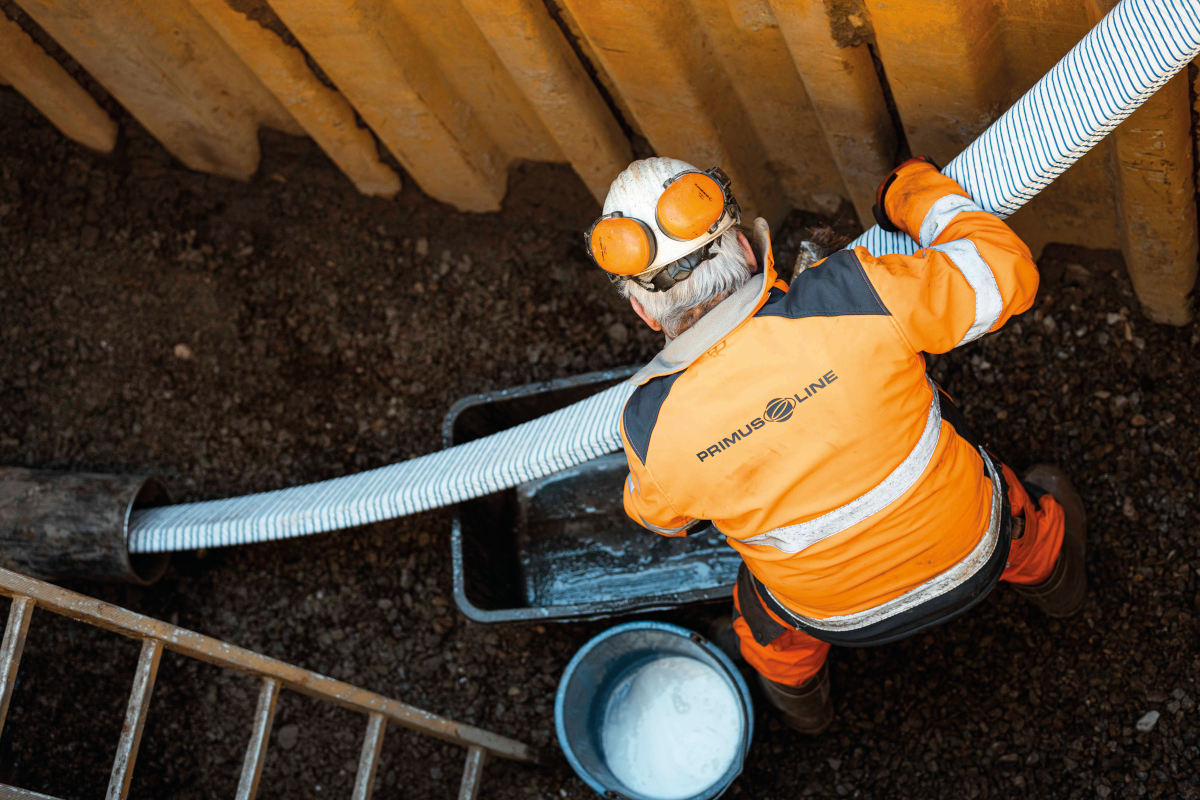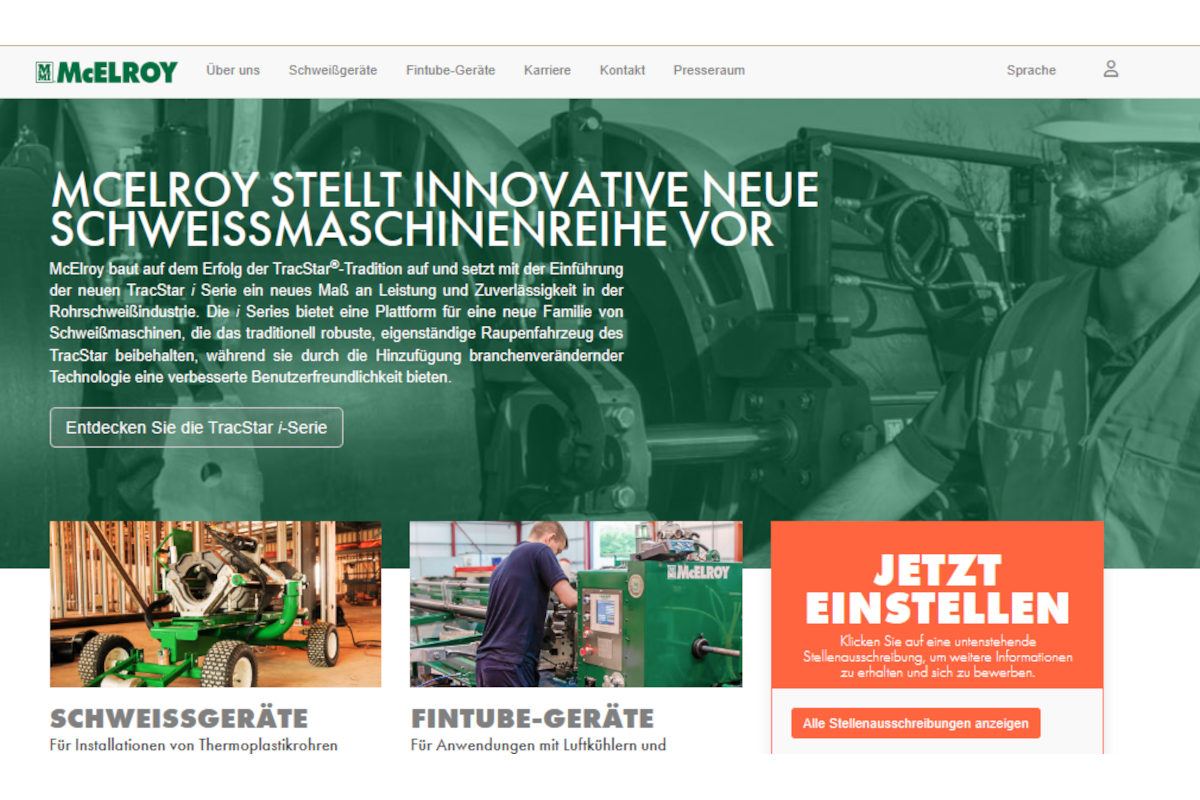Brandenburger Liner GmbH Makes Its Mark Underground
When Brandenburger Group was asked to collaborate onimproving an existing cured-in-place liner for a sewer rehabilitation contractorin 1990, who knew it would lead to such a successful business venture for thelong-established, German composite manufacturing company?
Well, if youposed that question to the leaders at Brandenburger, they were more thanconfident that entering the world sewer rehab market would be nothing less thana success and that their design of the liner would be something no other linercompany had developed. Beyond expanding its already strong product base with itscured-in-place liners for the sewer rehab market, Brandenburger has pushed thetrenchless technology envelope as a whole by incorporating ultra violet (UV)light-curing relining, which allows contractors to rehabilitate damaged sewerssafely and permanently in the quickest time possible — without chemical handlingonsite or digging.
Since entering the trenchless market 15 years ago,Brandenburger has carried out sewer rehabilitation projects in 18 differentcountries, with more than 1.3 million m (4.3 million ft) of 150- to 1,000-mm (6-to 40-in.) liner successfully installed.
But more than its strongpresence in the rehabilitation market, Brandenburger is proud of what it isaccomplishing within the walls at its Landau factory, such as its research anddevelopment department, which has led to many German and international patents.Its strong customer base that it has maintained over the years is opening thedoors to more markets abroad — to countries such as France, Japan, UnitedKingdom, Switzerland, Denmark and Australia, as well as the Middle East — astrenchless technologies are being utilized more and more to rehabilitate theworldwide, aging infrastructure.
With more than 100 employees,Brandenburger Liner GmbH is looking toward a bright future in sewerrehabilitation.
Background
Brandenburger developed itsseamless pipe liners for the trenchless market in the early 1990s. The basis forthis product was entrenched in decades of experience in the manufacturing andprocessing of glass-fiber reinforced composite materials plastics that thecompany had done for years. For more than 65 years, Brandenburger has been aleading manufacturer of high-technology advanced materials. In 1939, KurtBrandenburger laid the foundation for the company by constructing the world’sfirst high-temperature, heat protection shield factory. The company in Landau issituated in southwest Germany near the French border.
Today, Brandenburgeroffers high-tech products for heat protection systems, friction bearings, rotaryblades, ablation materials for aerospace applications and a wide range ofconstruction materials.
In 1990, Brandenburger entered a new field ofoperations with the production of cured-in-place liners and UV-hardeningequipment. “We entered the field of sewer rehabilitation by introducing the pipelining procedure in 1990, further expanding our product spectrum,” saysChristian Noll, managing partner. Noll has been with Brandenburger since theearly 1990s and has learned the trenchless technology market right along withthe company and the advent of its pipe lining process.
In 2001,Brandenburger added another company for sewer rehabilitation to serve and trainits rehab customers. Here, Brandenburger has bundled the results of extensiveR&D efforts with 10 years of consulting experience and liner installationsite. This gives Brandenburger direct experience in practical rehabilitation,which in turn flows into the development and production of its products andgives the best possibilities for training on the job.
So just how didBrandenburger become involved in sewer rehabilitation and trenchless technology?According to Noll, Brandenburger had worked with resins for nearly 50 years soits foray into the field wasn’t unusual. However, in the early 1990s, companyofficials were approached by a German resin manufacturer that was helping arehab construction contractor with a liner that the contractor had developed butcould not get to work.
“There was a rehab construction company that haddeveloped a liner and had many difficulties impregnating the ready sleeve to geta homogenous wet-out impregnation,” Noll says. “The manufacturer, which hadknown Brandenburger for a long time, asked if we could develop a solution tothis problem for the contractor. The basis of all the companies withBrandenburger Group involves working with resins but up until that time[Brandenburger] had no contact with the rehabilitation market.”
Noll saysthe problem with the contractor’s liner was that it was having trouble with aseam design, making insulation difficult. “But that wasn’t our liner,” Noll saysof the aid given to the contractor. “[Afterward,] we were having contact withthese companies more and more and we decided that it would be helpful to have acompletely new liner design with a seamless construction.”
And that wasthe origin of Brandenburger’s patented UV-Light Curing liner.
The Liner
The Brandenburger pipe liningprocess has set an international quality standard for trenchless sewerrehabilitation with its seamless pipe liners with UV light curing. The liner isa wound, seamless tube made from glass-fiber reinforced plastic (GRP)impregnated with high-grade resin. The liners have been manufactured at lengthsup to 250 m (825 ft) ready for use on rehab sites. The liners leave the factorypre-saturated with resin, controlled and documentated so that the resin isevenly distributed along the entire length of the liner. Thanks to the factoryproduction, the non-refrigerated transport and the long term storage, even overgreat distances, the treatment with resins and other chemicals on the jobsite isnot necessary.
Brandenburger not only has a high competence in theproduction of the liners, but the company develops and produces all the UV lightequipment in its facilities. “The pipe liners can be installed in even the mostdifficult to reach areas, thanks to the small portable UV light equipmentdeveloped in our facilities,” says Noll. “According to our experience, it isonly through the effective combination of these two technologies thathigh-quality curing at the jobsite is possible, ensuring the success of therehabilitation.”
Brandenburger uses only high-grade glass fiber and bestquality resins for its pipe liner production to offer long term pipe stability.The glass-fiber composite as the base material provides strength due to theextremely high proportion of the glass-fiber materials; the seamless design alsoensures its strength.
“Most crucial, however, is the speed at whichrehabilitation can be done,” Noll says, explaining that using the UV lightprocess to cure the liner is much faster than temperature curing.
Thequality of an installed GRP liner strongly depends on the applied curingtechnology — the UV light-curing process. Brandenburger’s UVA technology is thefirst that provides optimum control over the curing process, Noll says. Theentire process is controlled electronically and optically with TV cameras. Themost important criteria for the curing process are the intensity and duration ofthe light exposure. It is not necessary to add heat.
The timeframe tocure via UV light depends, of course, on the lengths involved. Noll estimatedthat approximately 120 m (up to 400 ft) can be cured per hour with the smallerdiameter liner, while 30 m (100 ft) per hour can be done using the larger liner,up to 40 in.
“Contractors want to provide their customers with the bestpossible service and that includes that the residents in the area should bebothered as little as possible during rehabilitation,” Noll says. “Light-curingGRP pipe liners definitely have the advantage here. At Brandenburger, weconstantly continue to develop the resins even more in order to ensure evenquicker cure times and thereby shorter construction times.”
In Germany,municipalities calculate a realistic service life of at least 50 years. “Asignificant advantage of the GRP material is that it truly can bepre-programmed,” Noll says. “Depending on the load and employment of thefinished product, the glass fiber in the composite materials can be aligned insuch a way that it can optimally sustain the bending, pulling and stretchingforces applied. For sewer rehabilitation, the high resistance of this materialagainst chemicals and corrosion in particular are important for the permeabilityand long service life of the GRP pipe liner.”
The Market
As trenchless rehabilitationprocedures with liners become more established around the world — especially inindustrialized, urban areas — and as the infrastructure continues to age,Brandenburger continues to reach out to more markets. Although the German andEuropean markets are the primary focus of Brandenburger, the company’s linersare used all over the world via licensees — something Brandenburger attributesto the quality of the liner and curing process, as well as its partner strategy.
“Today, the seamless liner is manufactured in Japan under license and wehave successfully completed projects in Australia, the United States, Canada andthe Middle East,” Noll says. “Since 2002, new partners were established inSwitzerland, Spain, Portugal, the Netherlands, France, Denmark, as well as inEngland and Scotland.
He added that Brandenburger is currently working toexpand its operations in Eastern Europe, as well as developing a partner that isactive in the Czech Republic and Slovakia.
Most recently at the IFAT2005 show in Munich, Brandenburger officials signed a cooperative agreement witha new U.S. partner — Reline.America — to represent its interests in NorthAmerica. Reline.America intends to replicate Brandenburger’s manufacturingfacility in America to service its customers in the United States, Canada andMexico.
The Landau factory supplies its partners in the European market.However, for the countries outside of Europe’s borders, Brandenburger puts itsfaith in its qualified and strong partners to manufacture the liner.
“Weknow of course that a chain is only as strong as its weakest link,” Noll says.“That is why we develop and market the entire system ourselves from theproduction to the required UV light-curing equipment, as well as offering ourpartners comprehensive services and training so they can install the pipe lineroptimally onsite… The demand for high-grade rehabilitation technology existsaround the world. We want to consistently expand our position here.”
Success
When discussing what makesBrandenburger so successful, Noll points to its state-of-the-art research anddevelopment department as it continues to improve its products in all facets ofthe Brandenburger Group.
“Research and development has always been thebasis for the Brandenburger corporation,” Noll says. “Not only in the productionof pipe liners, but Brandenburger is also leading in thermal insulation andworks closely with companies from the machine construction to aerospaceindustries. We want to be at the leading edge with our products and we,therefore, invest heavily in our own research and development.
“Not onlydid our company develop the worldwide-patented, seamless pipe liners, but the UVlight-curing equipment is the result of the efforts of our technicians andengineers as well.”
Noll also speaks highly of the collaborative effortsBrandenburger has made over the years with independent institutions,universities, prominent companies in the plastics industry and, perhaps mostimportantly, with its customers to continuously develop its productline.
“Customer orientation is the main tenet of our company’sphilosophy,” he says. “By maintaining a continuous dialog with those in chargeof a project, we learn about the special aspects of the respective marketsector, as well as our customers’ special needs. This allows us to make detailedassessments of problems and solve them in a competent manner.”
And givingits customers the highest quality product, service and price are of utmostimportance to Brandenburger, given the extremely competitive nature of the linermarket today, most notably in its home country. “It is a very, very competitivemarket, especially in Germany,” Noll says. “Our products are up to thecompetition in the markets of the world. The challenge is to offer the highestquality at a competitive price. The increasing awareness for comprehensiveenvironmental protection [i.e. avoiding exfiltrating sewage and infiltratingclean groundwater] will raise the importance around the world of rehabilitationand maintenance.”
Final Thoughts
Consistent quality andcustomer orientation. Research and development. Qualified and motivatedemployees. A fair partner strategy. These are the things that have made up andwill continue to make up the Brandenburger philosophy, Noll says.
“Together with our partners, we have shown in the past that by employingthe Brandenburger pipe lining procedure that the vast majority of damages insewers can be quickly and permanently fixed with a long term service life atleast 50 years renovated,” he says. “We want to continue to grow with thissuccessful strategy and provide our customers with sewer rehabilitation at thehighest standard.”




